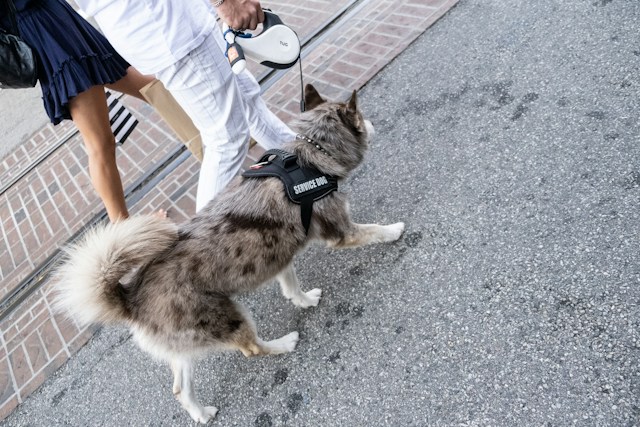How to Train a Service Dog for Someone with PTSD?

Service dogs have been a constant source of support and companionship for humans for many years. More recently, they have been utilized as a recovery tool for those living with Post-Traumatic Stress Disorder (PTSD). Training these dogs to support someone with PTSD, however, isn’t just about teaching them to sit and stay. It requires a unique skill set and a deep understanding of both dogs and the human mind. In this article, we’ll take a close look at the process of training a service dog for a person living with PTSD.
Why Service Dogs for PTSD?
PTSD is a mental health condition that affects those who have experienced traumatic events. Symptoms may include flashbacks, nightmares, severe anxiety, and uncontrollable thoughts about the event. For many individuals, traditional therapy may not be enough to manage the effects of this condition.
Also to discover : How to Set Up a Quarantine Tank for Sick Aquarium Fish?
Service dogs can provide a unique form of support for people with PTSD. They are specifically trained to perform tasks that can help to reduce the individual’s anxiety and create a sense of safety. These dogs are not just pets; they are lifelines.
The Selection Process
Not all dogs are cut out for the job of being a service dog. Before you even begin training, you’ll need to pick the right candidate. This is a dog that is physically healthy, emotionally stable, and has a calm and patient demeanor.
Also read : Tips for harmonious cohabitation between pets
Typically, dog breeds such as Labradors, Golden Retrievers, and German Shepherds are chosen due to their work ethic and temperament. However, the most important factor is the dog’s personality and suitability for the work, not its breed.
Puppies as young as 3 months old can begin their training as service dogs, but adult dogs can also be trained, provided they’re not too set in their ways. The selection process is crucial because the success of the service dog’s work greatly depends on their natural abilities and characteristics.
Basics and Beyond
After selection, it’s time to start training. This begins with basic obedience training – sit, stay, heel, and so on. But, a service dog for someone with PTSD needs to go far beyond these basic commands.
Service dogs for PTSD are trained to perform several specific tasks. They may be taught to recognize signs of anxiety or panic in their handler and respond by providing comfort or distraction. They can also be taught to wake their handler from nightmares or retrieve medication.
Training a service dog is a long-term commitment. It can take anywhere from 6 months to 2 years for a dog to be fully trained as a service dog. This requires patience and consistent effort from both the trainer and the dog.
Specialized PTSD Training
The actual PTSD-specific training involves teaching the dog to perform tasks that are directly related to the handler’s symptoms or that can mitigate the effects of the disorder.
For example, if the person with PTSD often experiences anxiety in crowded places, the dog can be trained to create a physical barrier between them and others. If the person has nightmares or flashbacks, the dog could be trained to turn on the lights or provide tactile stimulation to disrupt the distressing episode.
This part of the training is often individualized based on the specific needs of the person with PTSD. It’s important for the trainer to understand the handler’s symptoms and triggers to effectively train the dog.
Certification and Beyond
Once the dog has been fully trained, it can be helpful to have it certified as a service dog. This is not a legal requirement, but it can make things easier when it comes to public access rights.
There are also organizations that offer Public Access Tests, which assess whether the dog behaves appropriately in public settings. Passing this test can provide additional reassurance that the dog is ready to work as a service animal.
After certification, the most critical job begins: building the bond between the service dog and its handler. This process takes time and patience, but it’s the key to a successful working relationship. The handler and the dog must trust each other implicitly, and the dog must be attuned to the handler’s emotional state.
Training a service dog for someone with PTSD is a process that requires a deep understanding of both dogs and the human mind. It’s not a task to be undertaken lightly, but when done correctly, it can provide a lifeline for someone living with PTSD.
Service Dog and Handler: Nurturing the Bond
Building a deep and trusting relationship between the service dog and its handler is an essential part of the process that goes beyond just training. This bond is the foundation of the dog’s ability to understand and respond to the handler’s needs effectively.
Once the dog has been fully trained and possibly certified, it’s time to focus on nurturing this bond. The handler must spend a significant amount of time with the dog, engaging in activities that foster trust and mutual understanding. This could be simple daily tasks like feeding, grooming, and playing, or more structured activities like practicing commands.
The dog must learn to read the handler’s emotional state and respond accordingly. This means being attentive to subtle changes in behavior, body language, and even scent. Over time, the dog will become more attuned to the handler’s needs and will be able to respond more effectively to their PTSD symptoms.
It’s also crucial for the handler to build trust in the dog’s abilities. This may involve gradually introducing the dog to various environments and situations where the handler might experience PTSD triggers. This way, the handler can see firsthand how the dog can support them, thereby building their confidence in the dog’s abilities.
Remember, building this bond is not an overnight process. It requires patience, consistent effort, and a genuine love for the animal. The result, however, is a deep bond that can provide immense emotional support for someone living with PTSD.
Conclusion: The Lifeline of Service Dogs for PTSD
Training a service dog for someone with PTSD is a comprehensive process, requiring a deep understanding of both canine behavior and human psychology. From selecting the right candidate dog to basics training, specialized PTSD training, and nurturing a strong bond between the dog and its handler, every step is crucial in creating a successful PTSD service dog.
Certification can provide practical benefits, but it’s the bond between the dog and handler that truly determines their success as a team. This bond enables the dog to provide emotional support and assistance tailored to the handler’s specific needs and triggers.
While the journey to train a PTSD service dog may be long and demanding, the end result can be life-changing. These dogs are not just pets; they are lifelines, providing support, companionship, and comfort to those living with PTSD. They are constant reminders that even in the face of trauma, a sense of safety and understanding can be found in the unwavering love of a dog.
In conclusion, a well-trained service dog for someone with PTSD can make a profound difference in their life. It can help them navigate their daily life with more confidence and less anxiety, providing them a sense of safety and companionship that is invaluable.
